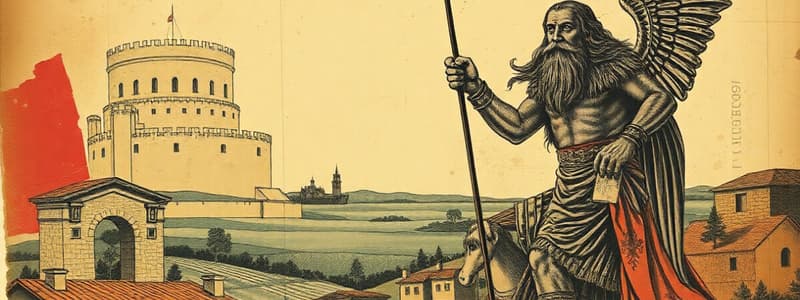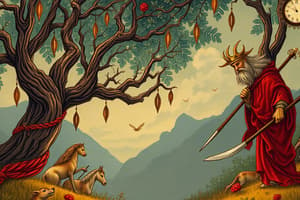Podcast
Questions and Answers
Which literary period is characterized by a focus on emotion, imagination, and the individual?
Which literary period is characterized by a focus on emotion, imagination, and the individual?
- Early 20th Century
- Modernist Period
- Victorian Period
- Romantic Period (correct)
Who wrote Frankenstein, a notable example of Gothic literature?
Who wrote Frankenstein, a notable example of Gothic literature?
- Mary Shelley (correct)
- George Eliot
- Jane Austen
- Charlotte Brontë
Which period is named after Queen Victoria?
Which period is named after Queen Victoria?
- The Romantic Period
- The Early 20th Century
- The Victorian Period (correct)
- The Modernist Period
Charles Dickens is a major novelist of which period?
Charles Dickens is a major novelist of which period?
Which literary period is characterized by experimentation, modernism, and a reaction to Victorianism?
Which literary period is characterized by experimentation, modernism, and a reaction to Victorianism?
Which of the following became a common narrative technique in the Early 20th Century?
Which of the following became a common narrative technique in the Early 20th Century?
Which movement influenced the Modernist Period, exploring themes of alienation and identity?
Which movement influenced the Modernist Period, exploring themes of alienation and identity?
Which of the following is a characteristic of Old English literature?
Which of the following is a characteristic of Old English literature?
What is a key characteristic of Late 20th and 21st Century Literature?
What is a key characteristic of Late 20th and 21st Century Literature?
Which historical event significantly influenced the development of Middle English literature?
Which historical event significantly influenced the development of Middle English literature?
Who is considered the most prominent playwright of the English Renaissance?
Who is considered the most prominent playwright of the English Renaissance?
Which of the following themes is commonly found in Old English literature?
Which of the following themes is commonly found in Old English literature?
Which literary work is a central piece of Middle English literature, offering a diverse portrayal of medieval society?
Which literary work is a central piece of Middle English literature, offering a diverse portrayal of medieval society?
What is a key characteristic of Restoration literature?
What is a key characteristic of Restoration literature?
Which genre became popular during the Restoration period, often satirizing the upper classes?
Which genre became popular during the Restoration period, often satirizing the upper classes?
Which of the following authors is associated with the 18th century?
Which of the following authors is associated with the 18th century?
Flashcards
English Literature
English Literature
Texts written in the English language across countries and time.
Old English Literature
Old English Literature
Literature from c. 450-1066, featuring oral tradition and alliterative verse.
Middle English Literature
Middle English Literature
Literature from c. 1066-1485, influenced by the Norman Conquest and French.
The Renaissance
The Renaissance
Signup and view all the flashcards
Hamlet
Hamlet
Signup and view all the flashcards
The Early Modern Period
The Early Modern Period
Signup and view all the flashcards
The Restoration
The Restoration
Signup and view all the flashcards
18th Century Literature
18th Century Literature
Signup and view all the flashcards
The Augustan Age
The Augustan Age
Signup and view all the flashcards
The Romantic Period
The Romantic Period
Signup and view all the flashcards
The Victorian Period
The Victorian Period
Signup and view all the flashcards
Modernism
Modernism
Signup and view all the flashcards
Stream of Consciousness
Stream of Consciousness
Signup and view all the flashcards
Realism
Realism
Signup and view all the flashcards
The Modernist Period
The Modernist Period
Signup and view all the flashcards
Postmodernism
Postmodernism
Signup and view all the flashcards
Study Notes
- English literature encompasses texts written in the English language from various countries and time periods.
- It includes a wide range of genres, such as poetry, drama, prose, and literary criticism.
- Its history spans from the Anglo-Saxon period to the present day, reflecting evolving social, political, and cultural contexts.
Old English (c. 450-1066)
- Also known as Anglo-Saxon literature, it is characterized by oral tradition and alliterative verse.
- Key works include "Beowulf," an epic poem, and religious writings by Cædmon and Cynewulf.
- The literature reflects a Germanic heroic culture and the influence of Christianity.
- Focus on themes of heroism, loyalty, and the struggle between good and evil.
Middle English (c. 1066-1485)
- The Norman Conquest (1066) brought French influence, transforming the English language and literature.
- Geoffrey Chaucer's "The Canterbury Tales" is a central work, offering a diverse portrait of medieval society.
- Other important works include "Sir Gawain and the Green Knight," a chivalric romance.
- Increased focus on romance, religious devotion, and social commentary.
- Development of new literary forms, such as the ballad.
The Renaissance (c. 1485-1660)
- Marked by a renewed interest in classical learning and a flourishing of the arts and sciences.
- William Shakespeare is the period's most prominent playwright, known for tragedies, comedies, and histories.
- Other major figures include Edmund Spenser ("The Faerie Queene") and Christopher Marlowe (Doctor Faustus).
- English Renaissance literature reflects humanism, individualism, and exploration.
- Development of the sonnet, dramatic blank verse, and prose essays.
The Early Modern Period
- Comprises the Jacobean, Caroline, Commonwealth and Restoration periods.
- Key Jacobean writers include John Webster, Ben Jonson, and John Donne
- Caroline writers include Robert Burton, George Herbert, John Milton
The Restoration (1660-1700)
- Restoration of the monarchy under Charles II led to a new era in literature and theatre.
- John Dryden was a dominant literary figure, known for his poetry, drama, and criticism.
- Comedy of manners became popular, satirizing the upper classes (e.g., William Wycherley, William Congreve).
- Emphasis on wit, reason, and social decorum.
- Development of the heroic couplet and formal verse satire.
The 18th Century
- Often divided into the Augustan Age and the Age of Sensibility.
- Major authors include Alexander Pope, Jonathan Swift, Samuel Johnson, and Jane Austen.
- The rise of the novel as a dominant literary form (e.g., Daniel Defoe, Samuel Richardson, Henry Fielding).
- Emphasis on reason, order, and classical ideals in the early part of the century.
- Growing interest in emotion, sentiment, and the individual in the later part of the century.
The Romantic Period (c. 1785-1832)
- Characterized by a focus on emotion, imagination, and the individual.
- Key poets include William Wordsworth, Samuel Taylor Coleridge, Lord Byron, Percy Bysshe Shelley, and John Keats.
- The rise of Gothic literature (e.g., Mary Shelley's "Frankenstein").
- Emphasis on nature, the sublime, and the exotic.
- Revolution against social and political norms.
The Victorian Period (1837-1901)
- Named after Queen Victoria, a period of significant social, economic, and technological change.
- Major novelists include Charles Dickens, George Eliot, the Brontë sisters, and Thomas Hardy.
- Important poets include Alfred, Lord Tennyson, Robert Browning, and Elizabeth Barrett Browning.
- Literature often addressed social issues, such as poverty, inequality, and the impact of industrialization.
- Realism and naturalism became prominent literary styles.
- Increased interest in science, psychology, and moral questions.
The Early 20th Century
- Characterized by experimentation, modernism, and reaction to Victorianism.
- Key figures include Joseph Conrad, James Joyce, Virginia Woolf, and T.S. Eliot.
- Stream-of-consciousness narrative and free verse become more common.
- Explores themes of alienation, disillusionment, and the fragmentation of modern life.
- Impact of World War I and changing social norms on literary themes and styles.
The Modernist Period
- Influenced by Sigmund Freud, Karl Marx, and Friedrich Nietzsche.
- Explored themes of alienation and identity.
- Noteworthy authors include T.S. Eliot, Ezra Pound, and James Joyce
Late 20th and 21st Century Literature
- Diversity of voices and perspectives, reflecting globalization and multiculturalism.
- Postmodernism challenges traditional literary conventions and explores metafiction.
- Continued exploration of identity, social justice, and environmental concerns.
- Prominent authors include Salman Rushdie, Toni Morrison, Margaret Atwood, and Kazuo Ishiguro.
- Blurring of genre boundaries and experimentation with form are common.
- Rise of postcolonial literature, exploring the legacies of colonialism and imperialism.
Studying That Suits You
Use AI to generate personalized quizzes and flashcards to suit your learning preferences.
Description
Overview of English literature including Old English (Anglo-Saxon) and Middle English periods. Key works such as Beowulf and The Canterbury Tales are included. Covers the themes, culture, and historical context of the literature.



